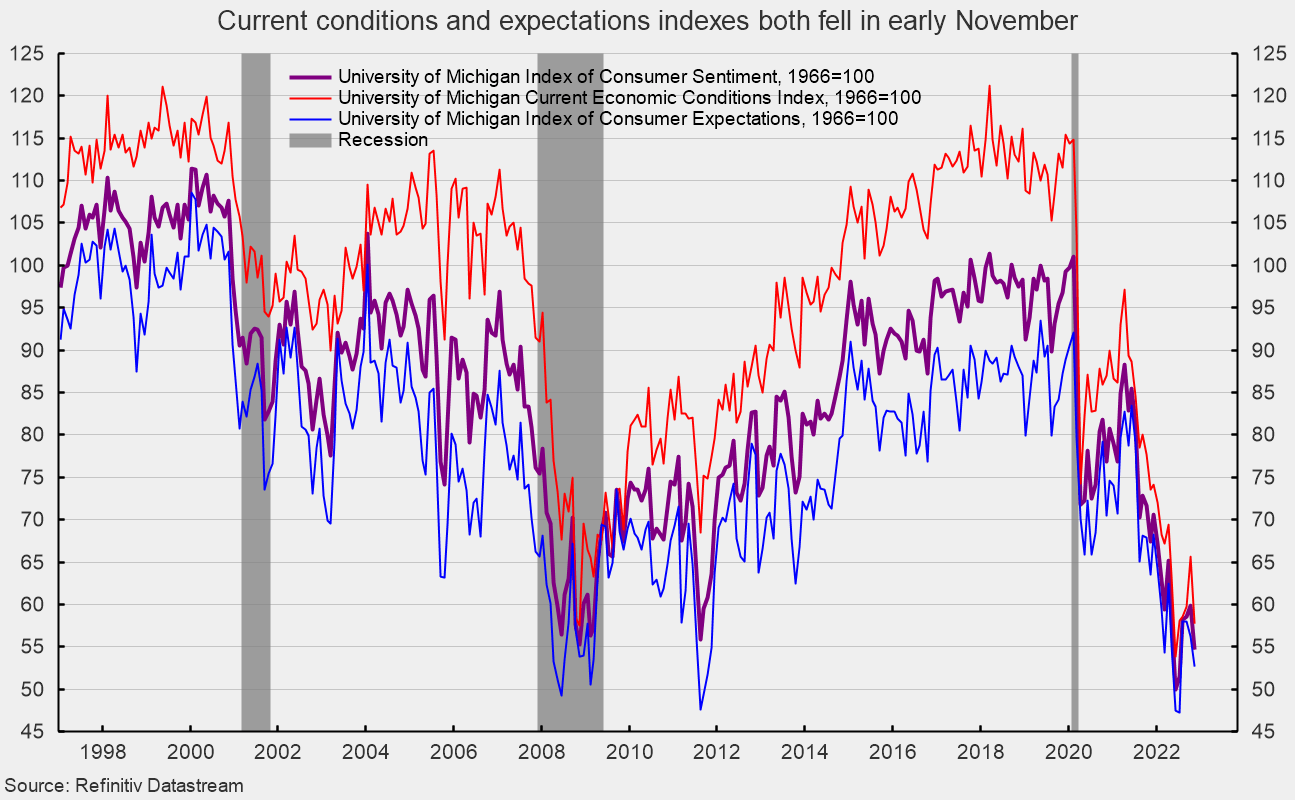The preliminary November results from the University of Michigan Surveys of Consumers show overall consumer sentiment declined in early November, holding near historically low levels (see first chart). The composite consumer sentiment decreased to 54.7 in early November, down from 59.9 in October. The index hit a record low of 50.0 in June down from 101.0 in February 2020 at the onset of the lockdown recession. The decrease in early November totaled 5.2 points or 8.7 percent. The composite index remains consistent with prior recession levels.

The current-economic-conditions index dropped to 57.8 versus 65.6 in October (see first chart). That is a 7.8-point or 11.9 percent decrease for the month. This component is just four points above the June low of 53.8 and remains consistent with prior recessions.
The second component — consumer expectations, one of the AIER leading indicators — fell 3.5 points, or 6.2 percent for the month, to 52.7. This component index is 5.4 points above the July 2022 low of 47.3 and remains consistent with prior recession levels (see first chart).
According to the report, “Consumer sentiment fell about 9% below October, erasing about half of the gains that had been recorded since the historic low in June.” The report adds, “All components of the index declined from last month, but buying conditions for durables, which had markedly improved last month, decreased most sharply in November, falling back 21% on the basis of high interest rates as well as continued high prices.” The report further notes, “Overall, declines in sentiment were observed across the distribution of age, education, income, geography, and political affiliation, showing that the recent improvements in sentiment were tentative. Instability in sentiment is likely to continue, a reflection of uncertainty over both global factors and the eventual outcomes of the election.”

The one-year inflation expectations bounced up in early November, rising to 5.1 percent. The result remains below the back-to-back readings of 5.4 percent in March and April but above the 4.7 percent reading in September (see second chart).
The five-year inflation expectations also ticked up, coming in at 3.0 percent in early November. That result is well within the 25-year range of 2.2 percent to 3.5 percent. It is also between the recent 2.7 percent low from September and the 3.1 percent high in June (see second chart).
The report states, “Inflation expectations are little changed. The median expected year-ahead inflation rate was 5.1%, up from 5.0% last month. Long run inflation expectations, currently at 3.0%, have remained in the narrow (albeit elevated) 2.9-3.1% range for 15 of the last 16 months.”
Pessimistic consumer attitudes reflect a confluence of events, with inflation leading the pack. Persistently elevated rates of price increases affect consumer and business decision-making and distort economic activity. Overall, economic risks remain elevated due to the impact of inflation, an aggressive Fed tightening cycle, and the continued fallout from the Russian invasion of Ukraine. The economic outlook remains highly uncertain. Caution is warranted.
Originally published by the American Institute for Economic Research. Republished with permission under a Creative Commons Attribution 4.0 International License.
More great content from Budget & Tax News











